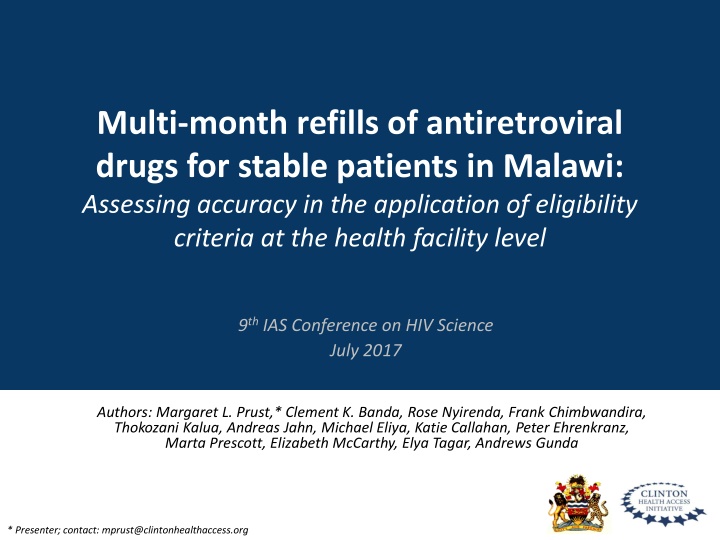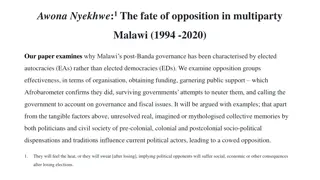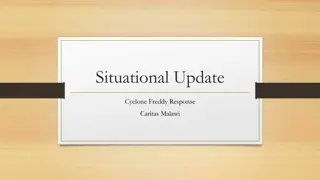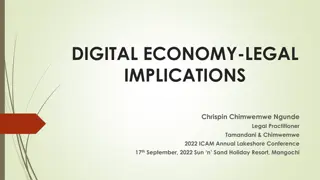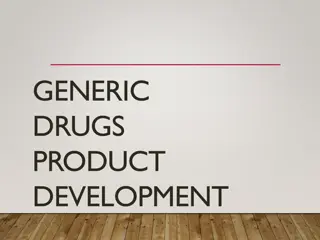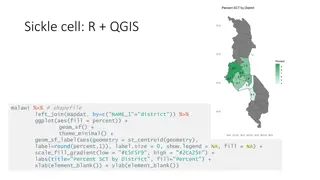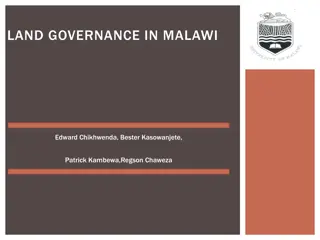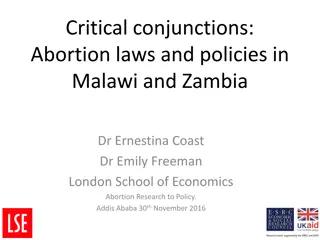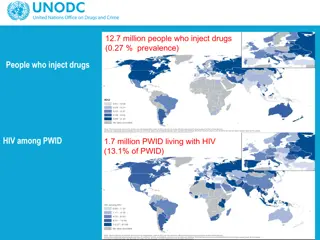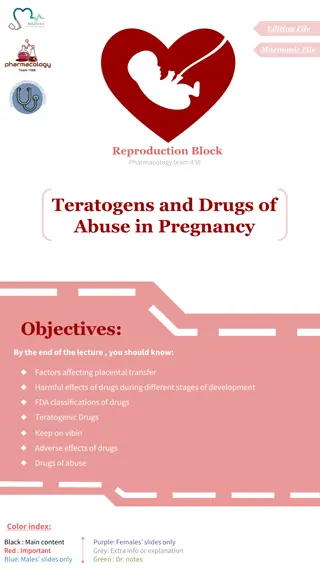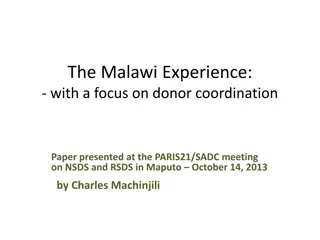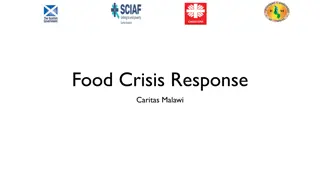Accuracy of Multi-Month Refills of Antiretroviral Drugs in Malawi
Understanding the implementation of multi-month refills for stable patients in Malawi provides valuable insights into patient eligibility differentiation, with 86% eligible for multi-month scripts. Challenges remain in accurately applying eligibility criteria, as seen in the study's findings. The research methodology involved data collection from various ART clinics, patient record reviews, health worker surveys, and interviews with clinic in-charges. The results indicate the need for improved accuracy in determining patient eligibility for multi-month refills in Malawi.
Download Presentation

Please find below an Image/Link to download the presentation.
The content on the website is provided AS IS for your information and personal use only. It may not be sold, licensed, or shared on other websites without obtaining consent from the author.If you encounter any issues during the download, it is possible that the publisher has removed the file from their server.
You are allowed to download the files provided on this website for personal or commercial use, subject to the condition that they are used lawfully. All files are the property of their respective owners.
The content on the website is provided AS IS for your information and personal use only. It may not be sold, licensed, or shared on other websites without obtaining consent from the author.
E N D
Presentation Transcript
Multi-month refills of antiretroviral drugs for stable patients in Malawi: Assessing accuracy in the application of eligibility criteria at the health facility level 9th IAS Conference on HIV Science July 2017 Authors: Margaret L. Prust,* Clement K. Banda, Rose Nyirenda, Frank Chimbwandira, Thokozani Kalua, Andreas Jahn, Michael Eliya, Katie Callahan, Peter Ehrenkranz, Marta Prescott, Elizabeth McCarthy, Elya Tagar, Andrews Gunda * Presenter; contact: mprust@clintonhealthaccess.org
Background Many countries are implementing or considering multi-month scripts (MMS) for stable patients in order to reduce burden on lifelong ART on patients and health systems In Malawi, the national ART guidelines have supported 3-month refills for stable adult patients since 2008 Little is known about how MMS policies are being implemented operationally in Malawi and elsewhere Objective: To assess the extent to which patients are accurately differentiated as eligible or ineligible for MMS and explore potential causes of inaccuracy in patient differentiation
Study methodology 30 public-sector ART clinics were purposefully sampled to achieve diversity in facility type, size, location, and partner support Data collection: 75,364 patient record reviews, from electronic data where available or from randomly sampled paper-based records 136 health worker surveys 32 interviews with ART clinic in-charges Analysis Quantitative data was cleaned and merged with support of electronic data managers; data was weighted based on different sampling proportions and clustered by facility Qualitative data was audio recorded, transcribed, and thematically coded by a team of three researchers
Approximately 86% of patients were eligible for MMS, and 69% of patients were receiving refills of 3 months Percentage of patients eligible for MMS Percentage of patients receiving MMS 4 months or more: 7% % of patients NOT meeting each criteria 100% Inclusion criteria 90% At least 6 months on ART 7.5% 6.2% Suppressed viral load 80% First-line regimen 2.5% 70% % of patients 3 month refills: 62% (55%-69%)*** No opportunistic infections 0.8% 60% No side effects 0.6% 50% Age 18 or older NA* 40% Good adherence NA** 30% 2 month refills: 19% 20% 10% 1 month or less: 13% 86.4% (95% CI: 84.0% - 88.6%) meet all criteria to be eligible for MMS in Malawi 0% Length of refill * Our study only collected data about the adult population. ** Due to inconsistencies in adherence data across record types we have not accounted for this criteria. Therefore the true percentage of eligible patients is likely to be somewhat lower than stated. *** Results are weighted and clustered to adjust for sampling so 95% confidence intervals are shown.
Inaccurate patient differentiation can limit benefits of MMS and present risks Percentage of eligible and ineligible patients receiving MMS 100% When ineligible patients access model, patients may not be getting the level of care recommended by guidelines When eligible patients do not get MMS, the optimal efficiency gains are not being experienced 80% 60% 40% 73% 42% 20% 0% Eligible Weighted equiv. n 65,000 Ineligible Weighted equiv. n 10,000 Receiving MMS Not receiving MMS
Inaccurate patient differentiation can limit benefits of MMS and present risks Percentage of eligible and ineligible patients receiving MMS 100% When ineligible patients access model, patients may not be getting the level of care recommended by guidelines When eligible patients do not get MMS, the optimal efficiency gains are not being experienced 80% 60% 40% 73% 42% 20% 0% Eligible Weighted equiv. n 65,000 Ineligible Weighted equiv. n 10,000 Receiving MMS Not receiving MMS According to health worker interviews, causes of incorrect patient differentiation may include facility- and patient-level factors: Failure to include eligible patients: Lack of knowledge about policy Provider concerns about MMS Low drug stocks Poor adherence not captured in eligibility measure for this study Inclusion of ineligible patients: Lack of understanding of criteria Attempt to reduce workload Unrecognized transition to becoming ineligible Patient requests
Health worker knowledge of criteria may explain some but not all of the cases of poor patient differentiation Percentage of ineligible patients receiving MMS that do not meet each criteria Based on the patient record reviews, ineligible patients receiving MMS most often did not meet the criteria for viral load, time on ART, and ARV regimen 100% 77% 80% 60% 39% 26% 40% 10% 9% 20% 0% Viral Load Time on ART ARV Side Effects OIs Regimen Percentage of health workers listing each criteria 72% 80% In the health worker survey, most nurses and clinicians mentioned viral load, ARV regimen, or age as criteria for MMS 62% 60% 58% 60% 34% 40% 16% 20% 2% 0% Viral Load / CD4 Time on ART ARV Side Effects OIs Adherence Age Regimen
There was variation across facilities in accuracy of patient differentiation Percentage of eligible and ineligible patients receiving MMS at each facility
There was variation across facilities in accuracy of patient differentiation Percentage of eligible and ineligible patients receiving MMS at each facility Inaccurate differentiation: Providing MMS to a similar percentage of eligible and ineligible patients (False positive rate or 1-Specificity) Accurate differentiation: Providing MMS to a high percentage of eligible patients and a low percentage of ineligible patients (Sensitivity) The percentage of ELIGIBLE patients getting MMS is a significant predictor of the percentage of INELIGIBLE patients getting MMS (coefficient 0.59, p value < 0.01)
Facility- and individual-level characteristics had some impact on misclassification, but no strong trends emerged FACILITY-LEVEL PREDICTORS OF TOTAL MISCLASSIFICATION PERCENTAGE Facilities in the Southern Region are slightly more likely to misclassify patients compared to the Central Region, but otherwise facility characteristics are not strong predictors of the total percentage of patients that are misclassified * Independent variable Region Central Northern Southern Facility type Hospital Health center Location Urban Peri-urban Rural Remote Number of active ART patients (per 1000) Patient to clinician ratio (per 500) Average number of eligibility criteria known by health workers at facility Coefficient p value ref 0.05 0.20 0.61 0.03 ref 0.11 0.12 ref -0.01 0.08 0.18 -0.02 0.01 0.92 0.37 0.25 0.12 0.87 *Facility-level analysis based on bivariate linear regression. **Individual analysis based on bivariate logistic regression. 0.02 0.70
Facility- and individual-level characteristics had some impact on misclassification, but no strong trends emerged FACILITY-LEVEL PREDICTORS OF TOTAL MISCLASSIFICATION PERCENTAGE FACILITY-LEVEL PREDICTORS OF THE ODDS OF MISCLASSIFICATION Facilities in the Southern Region are slightly more likely to misclassify patients compared to the Central Region, but otherwise facility characteristics are not strong predictors of the total percentage of patients that are misclassified * Based on individual-level data analysis, age and gender were significant predictors of the odds that a patient would be misclassified, but the influence of these factors was limited in terms of odds ratio change** Independent variable Region Central Northern Southern Facility type Hospital Health center Location Urban Peri-urban Rural Remote Number of active ART patients (per 1000) Patient to clinician ratio (per 500) Average number of eligibility criteria known by health workers at facility Coefficient p value ref Independent variable Male Age (per 10 years) OR (95% CI) 0.83 (0.74-0.94) 0.84 (0.78-0.91) p value 0.005 <0.001 0.05 0.20 0.61 0.03 ref 0.11 0.12 Similar results were observed in sensitivity analyses using other measures of diagnostic accuracy: Likelihood ratio Diagnostic odds ratio False positive rate ref -0.01 0.08 0.18 -0.02 0.01 0.92 0.37 0.25 0.12 0.87 *Facility-level analysis based on bivariate linear regression. **Individual analysis based on bivariate logistic regression. 0.02 0.70
Conclusions and recommendations MMS is being widely implemented in Malawi, but the eligibility criteria for this type of care are not being applied consistently Patient-level, health worker, and facility issues may collectively contribute to misclassification, but data did not show strong trends in predictors of misclassification As MMS and other models of differentiated care are expanded globally, policy makers, practitioners and researchers should consider the following recommendations: PROVIDING HEALTH WORKER TRAINING & SUPPORT Guidance on patient differentiation should be provided through job aides and health worker mentorship Electronic and paper patient records should be aligned with the eligibility criteria so that all necessary information is included; formatting of paper records and prompted in electronic records could improve health worker accuracy in differentiation ALIGNING PATIENT RECORD SYSTEMS CONDUCTING FURTHER RESEARCH Assessments are needed to examine patient outcomes among people receiving MMS that are eligible and ineligible in order to inform adjustments to eligibility criteria
Acknowledgements and additional information Additional results from this study are available in posters at this IAS meeting: The authors would like to thank: The Malawi MOH for support and collaboration in carrying out the evaluation Service delivery costs for HIV treatment under differentiated models of care for stable patients in Malawi (TUPED1327) The Bill and Melinda Gates Foundation for funding support Study participants for sharing their time and invaluable perspectives Baobab Health Trust and Medicines Sans Frontiers (MSF) for providing electronic patient data Patient and health worker perspectives on implementation of models of differentiated care for stable HIV patients in Malawi (TUPED1328) Data collectors and other CHAI Malawi staff that provided coordination and logistical support to this work, in particular: Nurse Nyambi, Alfred Kasito, Ivy Nnakabonge, and Jessica Joseph The authors have no conflicts of interest to declare.
